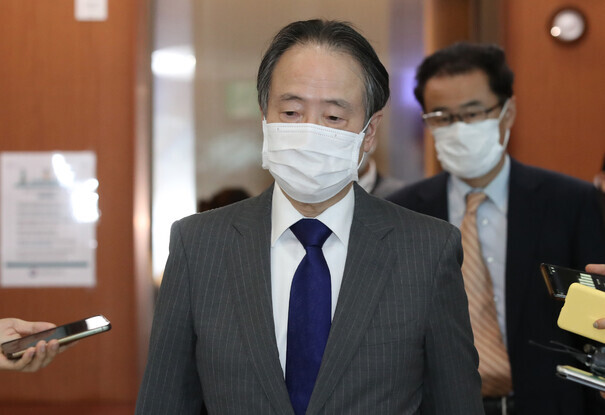hankyoreh
Links to other country sites 다른 나라 사이트 링크
S. Korea denounces Japan’s distortions of history surrounding Gunkanjima island

Attempts by Japan to distort the history of Gunkanjima (Hashima), an island with a history of forced labor by Koreans, are emerging as a new source of conflict with South Korea. The efforts by Japan are being seen as reflecting the influence of the Gunkanjima issue on compensation for survivors of forced labor mobilization.
On the afternoon of June 15, First Vice Minister of Foreign Affairs Lee Tae-ho summoned Japanese Ambassador to South Korea Koji Tomita to the Ministry of Foreign Affairs (MOFA) to strongly protest the Japanese government’s failure to honor the promise it made to “properly inform people of the history of forced mobilization of Koreans” when it registered Gunkanjima as a UNESCO World Heritage Site in 2015.
At a UNESCO World Heritage Committee meeting in Bonn in July 2015, Japan acknowledged that Koreans and others were “mobilized against their will” and “forced to work” at industrial sites on Hashima and elsewhere in the 1940s and pledged measures such as the establishment of an information center to remember the victims. At the time, the South Korean government took the Japanese government representative’s word and did not actively oppose Gunkanjima’s World Heritage Site registration.
Japan dishonors promise, attempts to portray positive image of Koreans’ living conditionsBut on a June 14 trip to the center a day ahead of its official opening, a group of reporters found that the Japanese government not only had failed to honor its promise, but had presented displays that misrepresented Koreans as having lived under good conditions on the island. Even the Japanese press raised issues over the response from the Japanese government. The Asahi Shimbun newspaper predicted on June 14 that South Korea “may raise issues over the inclusion of an interview with an island resident claiming there was no abuse or discrimination in connection with conscripted workers from the Korean Peninsula.”
Center director Koko Kato said there were “no political intentions” behind the display content in question.
“We interviewed over 70 island residents, and none of them said they had suffered abuse,” Kato explained. But the Kyodo News agency quoted an anonymous Japanese government source on June 14 as saying the Japanese government’s aim was to refute the established narrative that Korean workers were subjected to inhumane treatment on Hashima during the colonial occupation, which it viewed as a “self-flagellating view of history.” Commenting on the controversy in a regular press conference that afternoon, Deputy Chief Cabinet Secretary Naoki Okada sent a clear message that Tokyo has no intention of accepting Seoul’s protest and revising the content.
“With the exhibition content, a suitable determination was made based on the advice of experts in consideration of the World Heritage Committee’s resolution and recommendation,” he said.
Indeed, an examination of records of survivor accounts shows clear distortions on the part of the Japanese government. The 2010 book “Chikuho and Gunkanjima: After the Forced Mobilization of Koreans” by the late Eidai Hayashi, an author who wrote several books about the forced mobilization of Koreans, includes the stories of Kang Si-jeom -- a miner on Gunkanjima at the time -- and her husband. In the book, Kang is quoted as saying, “The [Japanese] labor supervisor did not treat Koreans like human beings. He regarded Koreans as the lowest beings on earth and did nothing but issue orders and fly into fits of rage.”
Unable to take life in the mines any longer, Kang suggested to her husband at one point that they “leave Nagasaki quickly and find different physical labor positions.” In response, he told her, “If you leave this island, they capture you as a ‘shimanuke’ (island fugitive) and kill you.”
By Gil Yun-hyung and Kim So-young, staff reporters
Please direct comments or questions to [english@hani.co.kr]
Editorial・opinion
![[Column] Season 2 of special prosecutor probe may be coming to Korea soon [Column] Season 2 of special prosecutor probe may be coming to Korea soon](https://flexible.img.hani.co.kr/flexible/normal/500/300/imgdb/original/2024/0426/3317141030699447.jpg) [Column] Season 2 of special prosecutor probe may be coming to Korea soon
[Column] Season 2 of special prosecutor probe may be coming to Korea soon![[Column] Park Geun-hye déjà vu in Yoon Suk-yeol [Column] Park Geun-hye déjà vu in Yoon Suk-yeol](https://flexible.img.hani.co.kr/flexible/normal/500/300/imgdb/original/2024/0424/651713945113788.jpg) [Column] Park Geun-hye déjà vu in Yoon Suk-yeol
[Column] Park Geun-hye déjà vu in Yoon Suk-yeol- [Editorial] New weight of N. Korea’s nuclear threats makes dialogue all the more urgent
- [Guest essay] The real reason Korea’s new right wants to dub Rhee a founding father
- [Column] ‘Choson’: Is it time we start referring to N. Korea in its own terms?
- [Editorial] Japan’s rewriting of history with Korea has gone too far
- [Column] The president’s questionable capacity for dialogue
- [Column] Are chaebol firms just pizza pies for families to divvy up as they please?
- [Column] Has Korea, too, crossed the Rubicon on China?
- [Correspondent’s column] In Japan’s alliance with US, echoes of its past alliances with UK
Most viewed articles
- 1[Column] Season 2 of special prosecutor probe may be coming to Korea soon
- 2No good, very bad game for Korea puts it out of Olympics for first time since 1988
- 3‘We must say no’: Seoul defense chief on Korean, USFK involvement in hypothetical Taiwan crisis
- 4Korea’s 1.3% growth in Q1 signals ‘textbook’ return to growth, says government
- 5Division commander ordered troops to enter raging flood waters before Marine died, survivor says
- 6Is N. Korea threatening to test nukes in response to possible new US-led sanctions body?
- 7Is Japan about to snatch control of Line messenger from Korea’s Naver?
- 8[Editorial] In the year since the Sewol, our national community has drowned
- 9[Editorial] 10 years on, lessons of Sewol tragedy must never be forgotten
- 10[Editorial] New weight of N. Korea’s nuclear threats makes dialogue all the more urgent